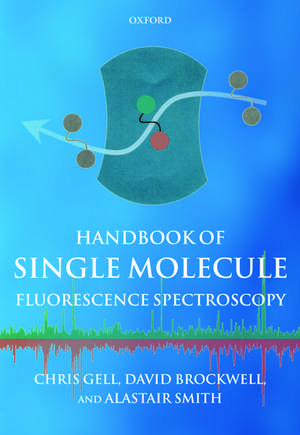Handbook of Single Molecule Fluorescence Spectroscopy
Autor Chris Gell, David Brockwell, Alastair Smithen Limba Engleză Hardback – 17 aug 2006
Preț: 835.81 lei
Preț vechi: 1265.76 lei
-34% Nou
Puncte Express: 1254
Preț estimativ în valută:
159.95€ • 166.38$ • 132.05£
159.95€ • 166.38$ • 132.05£
Carte tipărită la comandă
Livrare economică 04-10 aprilie
Preluare comenzi: 021 569.72.76
Specificații
ISBN-13: 9780198529422
ISBN-10: 0198529422
Pagini: 278
Ilustrații: 82 line drawings and halftones
Dimensiuni: 174 x 253 x 20 mm
Greutate: 0.72 kg
Editura: OUP OXFORD
Colecția OUP Oxford
Locul publicării:Oxford, United Kingdom
ISBN-10: 0198529422
Pagini: 278
Ilustrații: 82 line drawings and halftones
Dimensiuni: 174 x 253 x 20 mm
Greutate: 0.72 kg
Editura: OUP OXFORD
Colecția OUP Oxford
Locul publicării:Oxford, United Kingdom
Recenzii
An excellent book, ... the first text I know of that brings relevant information together in a consistent style. It could end up a classic in the field.
Notă biografică
Dr Chris GellSchool of Physics and AstronomyE C Stoner BuildingUniversity of LeedsLeeds LS2 9JTChris Gell obtained his MPhys. in Physics with Electronics and Instrumentation in 1998 from the University of Leeds. He then obtained his PhD in 2001 from the same institution. During his PhD he designed and constructed single molecule fluorescence spectroscopy instrumentation in Leeds and applied this to simple studies of protein folding. After his PhD he was appointed Laser Facilities Manager for the Institute of Molecular Biophysics in Leeds. In this ongoing position Chris has designed and constructed several additional types of single molecule instrumentation and helped to lead the varied single molecule fluorescence studies that are continuing in Leeds. In addition Chris is responsible for overseeing, maintaining and having intellectual input in a variety of other techniques and instruments in the institute, including: time-resolved and steady state luminescence spectroscopies.Prof. Alastair SmithSchool of Physics and AstronomyE C Stoner BuildingUniversity of LeedsLeeds LS2 9JTAlastair holds the Chair of Molecular Biophysics and is Director of the Institute of Molecular Biophysics at the University of Leeds. His undergraduate degree in Physics and PhD in the nonlinear optical properties of liquid crystals were awarded by the University of Manchester. Following a period of work in the Chemistry Department at the University of Pennsylvania, he was appointed as Lecturer in Physics at the University of Leeds in 1995. Since then his work has focused on the development of enabling technologies for structural molecular biology. He collaborates extensively with Life Scientists in the UK and internationally with a main research focus on protein folding and biological self-assembly. Dr David BrockwellSchool of Biochemistry and MicrobiologyUniversity of LeedsLeeds LS2 9JTDavid obtained his B.Sc. in Pharmacy from the University of Manchester in 1992 and registered as a Pharmacist after a qualification year at St. Bartholomew's Hospital, London in 1993. He then returned to Manchester and obtained his Ph.D in 1997. After six years post-doctoral work in the School of Biochemistry and Microbiology at Leeds, he was appointed to the academic staff of the same department jointly as part of the EPSRC funded Doctoral Training Centre and the newly created Institute of Molecular Biophysics. His main of area of research involves the use of single molecule techniques to characterise the mechanical properties of proteins and their complexes and the relation between these fundamental aspects of protein structure, stability and dynamics to the control of biological activity and homeostasis in vivo.
